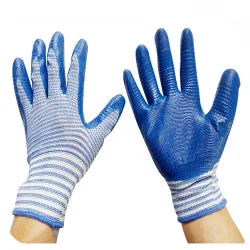Types of Garden Gloves
2024-05-17
Garden gloves are essential tools for anyone involved in gardening or yard work. They protect hands from dirt, thorns, blisters, and other hazards while providing better grip and comfort. There are various types of garden gloves designed for different tasks and conditions.
Types of Garden Gloves
1. Leather Gloves:
- Material: Usually made from cowhide, pigskin, or goatskin.
- Uses: Ideal for heavy-duty tasks such as pruning, handling thorny plants, or working with rough materials.
- Advantages: Durable, excellent protection against thorns and abrasions, good grip.
- Disadvantages: Can be less flexible and breathable, might be more expensive.
2. Cotton Gloves:
- Material: Made from cotton or cotton blends.
- Uses: Suitable for light-duty tasks like planting, weeding, and general garden maintenance.
- Advantages: Lightweight, breathable, inexpensive.
- Disadvantages: Not waterproof, less protection from thorns and sharp objects.
3. Rubber/Latex-Coated Gloves:
- Material: Typically cotton gloves with a rubber or latex coating on the palms and fingers.
- Uses: Good for tasks involving water or chemicals, such as mixing soil or fertilizers.
- Advantages: Waterproof, good grip in wet conditions, flexible.
- Disadvantages: Less breathable, can cause sweating.
4. Nitrile-Coated Gloves:
- Material: Nitrile coating over fabric gloves.
- Uses: Excellent for tasks requiring dexterity, such as planting seeds or handling delicate plants.
- Advantages: Puncture-resistant, flexible, good chemical resistance, breathable.
- Disadvantages: Less protection against thorns compared to leather gloves.
5. Synthetic Gloves:
- Material: Made from various synthetic materials like polyester, nylon, or spandex.
- Uses: Versatile, can be used for a wide range of gardening tasks.
- Advantages: Lightweight, flexible, often feature reinforced fingertips and palms for added durability.
- Disadvantages: Can vary widely in quality and protection.
Special Features
- Thorn-Proof: Some gloves are specifically designed to be thorn-proof with reinforced palms and fingers.
- Waterproof: Ideal for working in wet conditions or with water-sensitive plants.
- Breathable: Made with materials that allow air to circulate, keeping hands cool and dry.
- Adjustable Cuffs: Ensure a secure fit and keep dirt and debris out.
- Touchscreen Compatibility: Some modern gloves allow you to use touchscreen devices without removing them.
Choosing the Right Garden Gloves
1. Task: Consider the type of gardening tasks you'll be performing. Heavy-duty tasks require more robust gloves, while light tasks can be done with more flexible and lightweight gloves.
2. Fit and Comfort: Gloves should fit well without being too tight or too loose. Comfort is essential for prolonged use.
3. Material: Choose the material based on the specific needs of your gardening tasks. Leather for heavy-duty protection, cotton for breathability, and nitrile or rubber for waterproofing.
4. Durability: Look for gloves that can withstand wear and tear. Reinforced fingertips and palms add to the longevity.
5. Weather Conditions: Consider the weather conditions in your area. Waterproof gloves are useful in rainy regions, while breathable gloves are better for hot climates.
Maintenance and Care
- Cleaning: Regularly clean your gloves according to the material type. Leather gloves may need special leather cleaners, while cotton and synthetic gloves can often be machine-washed.
- Drying: Allow gloves to air dry completely before storing them to prevent mold and mildew.
- Storage: Store gloves in a dry, cool place away from direct sunlight to maintain their integrity.
In conclusion, garden gloves are a crucial accessory for any gardener, providing protection, comfort, and efficiency. Choosing the right type of gloves tailored to specific gardening tasks and conditions will enhance your gardening experience and ensure your hands stay safe and comfortable.



